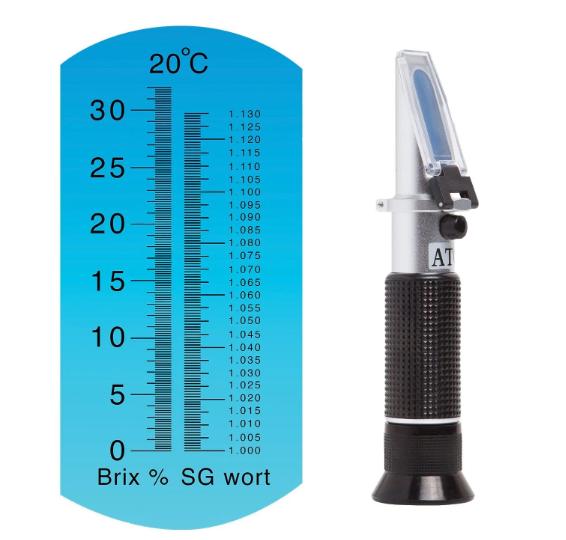When trying to determine a liquid’s sugar content, you have two main options: a hydrometer or a refractometer to measure specific gravity. Hydrometers and refractometers measure different things. Many have explained a big difference in the measurement of specific gravity between the two tools. This blog post will discuss the big difference between a refractometer vs hydrometer and help you decide which one is right for you when you brew beer! Having at least one of these tools is important for the brewing process.
What is Hydrometer?
Hydrometers measure the density of a liquid. This is done by measuring the amount of flotation of a Hydrometer in the liquid. The more sugar that is dissolved in a liquid, the more dense the liquid will be. It is used to measure sugar levels, determine alcohol content, and track how well the yeast functioned throughout the fermentation process at the start and finish of the process.
Hydrometer measurements are affected by temperature, so it is important to consider the temperature of the liquid when doing final gravity readings. This is important in brewing because it enables you to assess how well each fermenting beer is going, making future modifications and enhancements possible.
A Hydrometer is a glass instrument with a cylindrical shape and a weight at the bottom. The Hydrometer is placed in the liquid being tested and floats according to how dense the fluid is. There will be a line on the Hydrometer that indicates where the surface of the liquid rests. There are also nonglass versions of hydrometers that are much more durable. Using a hydrometer and test jar, you can also use a combo in measuring finished beer.
Advantages:
- Hydrometers are relatively inexpensive.
- Hydrometers can measure a wide range of densities, from that water to honey.
- Hydrometers are easy to use and only require a sample of the liquid being tested.
Disadvantages:
- Hydrometers are less accurate than refractometers.
- Hydrometers can be difficult to read because of the small markings.
- Hydrometers require calibration for each specific gravity reading.
- Hydrometers are breakable and need to be handled with care.
What is Refractometer?
A Refractometer is an optical instrument that measures the index of refraction (the amount of bending of light) of a liquid. The more sugar dissolved in a liquid, the higher the index of refraction will be. Refractometers are used to measure the sugar content of a solution, determine the ripeness of fruits, and assess the quality of honey.
This is important in brewing beer because it allows you to determine the final gravity of your beer, which is a good indicator of how much sugar has been fermented by the yeast. You cannot use a refractometer to miss your final gravity, only the original gravity.
A Refractometer works by shining a light through a drop of liquid on a glass plate. The light bends as it passes through the liquid and hits a scale. The amount of bending is measured and used to calculate the index of refraction. Use a refractometer and conversion calculator to take my final gravity readings.
A refractometer measures the sugar in your wort to more accurately track the productivity of your yeast and beer, just like a hydrometer does. Refractometers need a small sample and only a few drops of the liquid to get an instant measurement, unlike the Hydrometer that needs to be submerged.
This is great if you’re brewing small batches or if you want to maximize your final amount of beer. It’s also super helpful since you can take measurements during the mash, boil, and throughout the brew day, making sure you’re on target for your original gravity. Another positive is that refractometers have an auto temperature compensation, meaning you don’t have to worry about the temperature of your sample.
Refractometer measurements can be trickier, although the small sample size is a significant advantage. For starters, they must be calibrated using a sample of distilled water, which can be challenging to do the first time correctly. Furthermore, most refractometers measure samples in Brix, which must be translated to a gravity or Plato measurement, which is typically difficult.
Advantages:
- Refractometers are more accurate than hydrometers.
- Refractometers only require a small sample size.
- Refractometers are easy to use once they are calibrated.
Disadvantages:
- Refractometers can be expensive.
- Refractometers require calibration for each specific gravity reading.
- Refractometers can only measure the sugar content of a liquid.
CHECK OUT: Beer Brewing Calculator Review: Brewer’s Friend
Which is one to Buy?
There is no question that a hydrometer is necessary if you want to brew your own beer at home or even become a professional. Consider it to be an essential requirement.
You might consider purchasing a refractometer to be more accurate with your measurements and produce better brews. It will make brewing easier and your beer even better.
If you’re starting, invest in a hydrometer; it’s likely included in your first home brewing kit. When it makes sense, upgrade to a better one.
When you’ve got your basic brewing setup, upgrade your thermometers and add a refractometer to your toolset.
Conclusion
Depending on the instrument you select, a hydrometer or a refractometer is essential to gauge the amount of sugar to ethanol and monitor yeast success rates. Never stop updating your equipment once you’ve caught the beer-brewing bug; it’s fun, so don’t stop there.
Read next: 7 Easy Ways To Add Personalization To Your Beer Koozies




